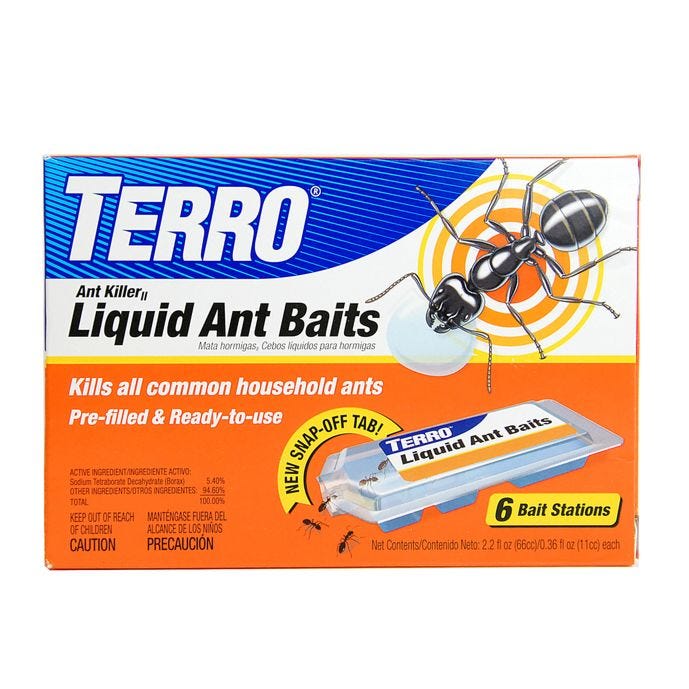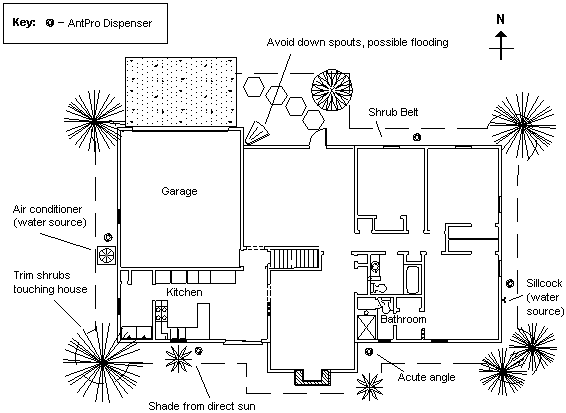The best place to put ant traps is where ants can easily find them, away from pets and children. Place near nests or on ant trails for effectiveness.
When dealing with an ant infestation, proper placement of ant traps is crucial for successful baiting. Knowing where to place ant traps can significantly impact their efficiency in targeting colonies. By strategically locating bait stations where ants frequent, you can effectively control and eliminate ant populations in your home or garden.
Implementing proper bait placement techniques ensures that ants are attracted to and take the bait back to their nests, ultimately eradicating the entire colony. Follow these guidelines to maximize the effectiveness of ant traps and effectively manage ant infestations in your environment.

Credit: www.terro.com
Choosing The Right Location For Ant Traps
To find the best place to put ant traps, consider placing them near ant nests, on ant trails, beneath plants, or along edges where ants travel. Ensure the traps are easily accessible to ants but not to pets or small children.
Additionally, avoid placing baits directly on countertops or anywhere where they may contaminate food or water sources.
Importance Of Proper Placement
Placing ant traps in the right location is crucial to effectively eliminate ant infestations. By choosing the right placement, you can maximize the chances of attracting ants to the traps and prevent them from accessing areas that are accessible to pets and small children.Factors To Consider
When deciding where to put ant traps, it is important to consider the following factors:Ant Trails and Nests: Look for signs of ant activity, such as ant trails or nests. Place ant traps along these trails or near the nests to intercept the ants on their way.Accessibility: Ensure that the ant traps are easily accessible to ants. Avoid placing them in areas that are difficult for ants to reach, such as high shelves or tight corners.Areas of Activity: Identify areas where ants are frequently seen, such as the kitchen, bathroom, or outdoor spaces. These are usually areas where ant traps should be placed to target the most active areas.Food Sources: Ants are attracted to food sources, so it is essential to place ant traps near these areas. Common spots include near food storage areas, garbage cans, and countertops.Avoiding Contamination: Keep ant traps away from areas where they can potentially contaminate food or water sources. Ensure that they are placed on stable surfaces and away from food preparation areas.Conclusion
Choosing the right location for ant traps plays a crucial role in effectively eliminating ant infestations. By considering factors such as ant trails, accessibility, areas of activity, and food sources, you can strategically place ant traps to attract and eliminate ants. Remember to always prioritize safety by keeping ant traps out of reach of pets and children, and away from food preparation areas.Tips For Placement Of Ant Traps
Place ant traps in areas easily accessible to ants, but out of reach of pets and children. Ideal spots include near ant nests, along ant trails, and around the edges where ants travel.
Near Ant Nests
Place ant traps close to where ants are likely to build their nests, such as in cracks, crevices, or behind appliances.
Along Ant Trails
Position ant traps along the paths where ants frequently travel, such as baseboards, windowsills, or entryways.
Out Of Reach Of Children And Pets
Avoid placing ant traps in areas accessible to kids and animals, like under furniture or cabinets.
Duration Of Ant Traps
Aim: To determine the most effective duration for using ant traps.
Ant traps should be placed where ants are active to ensure effectiveness.
Regularly monitor and replace traps until ant activity diminishes.
Recommended Timeframe For Use
- Initial placement should last at least 2-3 weeks to gauge effectiveness.
- Continue using ant traps until no ant activity is observed for 1-2 weeks.
- If ants reappear, reapply traps for another cycle of 2-3 weeks.
Impact Of Ant Traps
Ant traps attract ants to eliminate the entire colony for lasting control.
Presence of more ants initially indicates bait effectiveness.
Place bait stations strategically to ensure swift colony eradication.
Avoid placing traps near food preparation areas or where pets can access.

Credit: www.youtube.com
Effect Of Ant Traps On Ant Infestation
Attractiveness To Ants
Ant traps are designed to be highly attractive to ants, enticing them with a combination of food and enticing scents. The baits used in these traps are formulated to mimic the smell of ant pheromones, making them irresistible to ants. This attraction is crucial for the success of ant traps, as it ensures that the ants are lured towards the bait rather than other areas of your home.
When placing ant traps, it is important to consider the attractiveness of the bait to the specific ant species that you are targeting. Different species of ants are attracted to different types of food, so using a bait that matches their preferences will increase the effectiveness of the trap.
Impact On Colonies
Ant traps not only attract ants but also contain active ingredients that are toxic to them. Once the ants consume the bait, they carry it back to their colony, where it spreads among the other ants. This is important because it allows the bait to reach the queen and the rest of the colony, effectively eliminating the source of the infestation.
The active ingredients in ant traps disrupt the ants’ nervous system, leading to paralysis and eventual death. This not only reduces the number of worker ants but also weakens the overall functionality and resilience of the colony.
By strategically placing ant traps near ant trails, nests, or along the edges where ants travel, you can ensure maximum exposure to the bait and increase the chances of eliminating the entire colony.
It is important to note that the process of eliminating an ant infestation may take some time. The bait needs to be carried back to the nest and spread among the ants, which can take a few days or even weeks, depending on the size of the colony. Therefore, it is essential to be patient and allow the ant traps to work their magic.
Safety Considerations For Ant Traps
When placing ant traps, consider accessibility for ants and safety for pets and children. Optimal locations include near nests, on ant trails, and along edges where ants frequently travel. Avoid placing traps near food-preparation areas and keep them out of reach to prevent contamination.
Safety Considerations for Ant Traps—Ant traps are an effective way to tackle ant infestations, but it’s crucial to consider safety when placing them. Avoiding Contamination is important to ensure the traps work efficiently, and Proper Placement in Homes is essential to keep them out of reach of pets and children. Let’s delve into these safety considerations for ant traps:### Avoiding ContaminationWhen placing ant traps, it’s crucial to avoid contamination. The bait should not be placed directly on countertops where food is prepared, as this can lead to accidental contamination. A recommended approach is to place bait stations in areas where they won’t get wet or come into contact with food or water. Additionally, ensuring that the bait is out of reach of children, pets, and wildlife is essential to prevent unintentional exposure.### Proper Placement in HomeEnsuring the proper placement of ant traps in homes is vital for their effectiveness and safety. Avoid placing them in areas accessible to pets and small children. Instead, position bait stations near ant nests, on ant trails, beneath plants, or along edges where ants frequently travel. This strategic placement allows the bait to be easily accessible to ants while minimizing the risk of interference from pets and children.In conclusion, prioritizing safety considerations when placing ant traps plays a significant role in their effectiveness and overall safety in a household. By adhering to these guidelines, you can effectively address ant infestations while minimizing potential risks to residential occupants.
Credit: www.kmantpro.com
Frequently Asked Questions Of Best Place To Put Ant Traps
Where Should I Put Ant Traps?
Place ant traps near nests, on trails beneath plants, or where ants travel. Avoid pet-accessible areas. Utilize bait stations effectively.
How Long Should You Leave Ant Traps Out?
Leave ant traps out until the infestation is resolved. The time it takes to eliminate ants with ant traps can vary depending on the size of the colony and the effectiveness of the bait. Monitor the traps regularly and replace them if necessary.
Do Ant Traps Bring In More Ants?
Ant traps may attract more ants initially because the bait is highly attractive. However, this helps eliminate the colony faster. Place traps where ants can find them easily without being accessible to pets or children. Ensure they are away from food preparation areas and avoid wet locations.
Is It Safe To Put Ant Traps Near Food?
Yes, it is safe to put ant traps near food, but avoid placing them where they can contaminate food or be reached by children or pets. Proper placement is crucial.
Conclusion
The best place to put ant traps is where ants can easily find them, but out of reach of pets and children. These areas can include near nests, on ant trails beneath plants, or along edges where ants commonly travel.
By strategically placing ant traps, you can effectively eliminate ant colonies and prevent further infestations in your home. Remember to follow safety guidelines and keep the bait away from food preparation areas to ensure the well-being of your household.

I’m MD Tanvir, and I bring years of expertise gained from working closely with pest control companies to the forefront. My journey in the industry has inspired me to launch Bug Battler, a platform aimed at equipping people with the know-how to combat pests autonomously. Through Bug Battler, I aim to empower individuals with practical insights to tackle pest infestations effectively.

